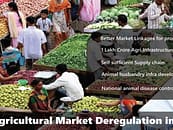A brief overview before we talk about Credit Risk in Agricultural Lending. Agriculture as a sector is labour and capital intensive in India. It employs over 55% of the population but the share in GDP turns out to be little short of 20%. India is known to be an agrarian economy but this sector is losing lustre due to financial distress at each level. The rising cost of farm inputs, labours, machinery and diminishing profits is making it less attractive as a profession for youth. As per experts, there will be Credit Risk in Agricultural Lending in India. The agriculture landscape is also shifting with the advent of Industry 4.0. The returns on agriculture take a longer time and hence people are reluctant to invest.
Traditionally, small farmers resorted to non-institutional lenders for credit at exorbitantly high interest rates primarily due to lack of institutional credit system and their own convenience or lack of awareness. This has resulted in farmers committing suicide. Historically the high rates have always been a problem, farmers have always been exploited by traditional money lenders. However, a lot of measures were put in place by the Government and the RBI to enhance the reach of formal banking systems in rural areas by establishing new branches in rural areas, Cooperative banks; Self Help Groups to name a few that focused on easy access to credit to the farming and allied sector workers to reduce the Credit Risk in Agricultural Lending.
India needs to solve the problem of Credit Risk for farmers
In spite of great measures and initiatives in the right direction, the agrarian sector is yet to receive the financial credit injection it deserves. The simple reason of Credit Risk in agriculture is the fact that agriculture is inherently a risky business that doesn’t guarantee timely repayment due to an array of uncontrollable factors. This eventually leads to reluctance to lend out credit freely to the needy. On the top of this, poor rural infrastructure, lack of branch networks lead to high cost of information for the institution making the portfolio unsavoury for the credit institutions. So the bottom line is the there is a Credit Risk in Rural Lending and it is a risky venture.

When the conventional frameworks fail the system, innovation gets the wheel rolling. This is where Non-Banking Financial Companies fill the gap. Some of them have invented a “Value Chain Finance” model that works at a level or two above the production cycle so as to impact the farmers positively. An AMLA (Aggregation, Marketing Linkage and Advisory) framework has been put in place to churn the best out of the business for the farmers due to better bargaining power as an aggregator which will, in turn, support the Credit Risk in Agricultural Lending.
This aggregate power is used to bargain for the price of farm inputs and also ensure the best prices while selling the produce. The quality is maintained through the advisory services where best practices are put in place.
With the advent of Agritech there would be transparency in the lending process, lending rates are expected to decrease, a farmer’s financial literacy is expected to increase and more money is expected to be injected into the sector.
Companies to watch:
Moody’s Analytics, Samunnati, Bajaj Finance, Mahindra Finance
Read our other articles:
ICAR is the R&D backbone of India’s agriculture







